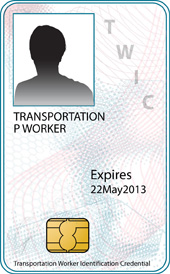Security Identification Display Area, or SIDA, is a special security area designated by an airport operator in the US to comply with Transportation Security Administration (TSA) requirements in CFR 49 1542.205. An identification system must be used in this area. Before allowing unescorted access to this area, a person must be trained and their background investigated. Normally, the flight ramp and other sensitive operational areas of a US commercial airport are designated as a SIDA.

The Transportation Security Administration (TSA) is an agency of the U.S. Department of Homeland Security that has authority over the security of the traveling public in the United States. It was created as a response to the September 11 attacks.

The Code of Federal Regulations (CFR) is the codification of the general and permanent rules and regulations published in the Federal Register by the executive departments and agencies of the federal government of the United States. The CFR is divided into 50 titles that represent broad areas subject to federal regulation.
CFR Title 49 - Transportation is one of fifty titles comprising the United States Code of Federal Regulations (CFR). Title 49 is the principle set of rules and regulations issued by the Departments of Transportation and Homeland Security, federal agencies of the United States regarding transportation and transportation related security. This title is available in digital and printed form, and can be referenced online using the Electronic Code of Federal Regulations (e-CFR).
Systems similar to SIDA identification card system exists in Australia (known as Aviation Security Identification Card or ASIC) and in Canada (known as Restricted Area Identity Card or RAIC).

Australia, officially the Commonwealth of Australia, is a sovereign country comprising the mainland of the Australian continent, the island of Tasmania, and numerous smaller islands. It is the largest country in Oceania and the world's sixth-largest country by total area. The neighbouring countries are Papua New Guinea, Indonesia, and East Timor to the north; the Solomon Islands and Vanuatu to the north-east; and New Zealand to the south-east. The population of 25 million is highly urbanised and heavily concentrated on the eastern seaboard. Australia's capital is Canberra, and its largest city is Sydney. The country's other major metropolitan areas are Melbourne, Brisbane, Perth, and Adelaide.
An Aviation Security Identification Card (ASIC) is an Australian identification card that shows that the holder of the card has undergone a security check and is suitable to enter a secure area of an Australian Airport. Security checks are performed by AusCheck and include a criminal records check undertaken by the Australian Federal Police, a security assessment conducted by the Australian Security Intelligence Organisation (ASIO) and an unlawful non-citizen check conducted by the Department of Immigration and Citizenship (DIAC). An ASIC is required for all personnel working at a security controlled airport in Australia. Personnel requiring access to a secure airport who are under the age of 18 are required to display an ASIC however issuing bodies can not apply for a security check. An ASIC has to be renewed every two years except for someone who has applied for an ASIC before they turned 18 in which case an ASIC is valid until 6 months after the person's 18th birthday. Only people with an operational need to enter a secure airport may apply for an ASIC. The goal of the ASIC is not just to prevent terrorist activities at airports but to ensure aircraft, equipment and facilities can not be tampered with.

Canada is a country in the northern part of North America. Its ten provinces and three territories extend from the Atlantic to the Pacific and northward into the Arctic Ocean, covering 9.98 million square kilometres, making it the world's second-largest country by total area. Its southern border with the United States, stretching some 8,891 kilometres (5,525 mi), is the world's longest bi-national land border. Canada's capital is Ottawa, and its three largest metropolitan areas are Toronto, Montreal, and Vancouver.










